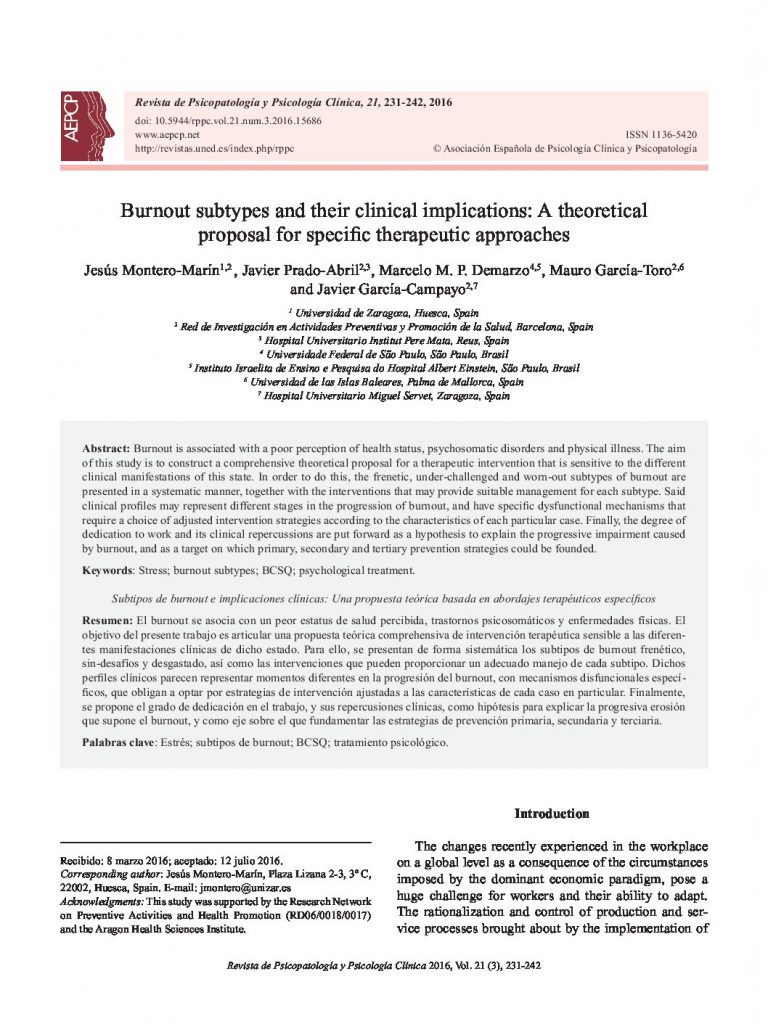Burnout subtypes and their clinical implications: A theoretical proposal for specific therapeutic approaches.

- Efficacy of transdiagnostic cognitive-behavioral therapy for anxiety and depression in adults, children and adolescents: A meta-analysis.
- Bipolar remitted patients show emotionrelated bias in memories of lifelike events: A study based on the virtual reality paradigm.
- Validación del Cuestionario Tridimensional para la Depresión (CTD) en población venezolana con enfermedades crónicas.
- Factorial validity of the Spanish version of the Geriatric Anxiety Inventory (GAI): Empirical analysis of its structure and dimensions.
- El continuo de la psicosis: Evidencia psicométrica.
- Psicopatología de las compulsiones de lavado en el trastorno obsesivo-compulsivo: No todos los pacientes lavan por los mismos motivos.
- Burnout subtypes and their clinical implications: A theoretical proposal for specific therapeutic approaches.
- Profesor Dr. Vicente Pelechano Barberá (1943-2016)
- Remedios González Barrón e Inmaculada Montoya-Castilla (Coords.)(2015): Psicología Clínica Infanto-Juvenil
- Información sobre los criterios de calidad de la Revista de Psicopatología y Psicología Clínica.
Burnout is associated with a poor perception of health status, psychosomatic disorders and physical illness. The aim of this study is to construct a comprehensive theoretical proposal for a therapeutic intervention that is sensitive to the different clinical manifestations of this state. In order to do this, the frenetic, under-challenged and worn-out subtypes of burnout are presented in a systematic manner, together with the interventions that may provide suitable management for each subtype. Said clinical profiles may represent different stages in the progression of burnout, and have specific dysfunctional mechanisms that require a choice of adjusted intervention strategies according to the characteristics of each particular case. Finally, the degree of dedication to work and its clinical repercussions are put forward as a hypothesis to explain the progressive impairment caused by burnout, and as a target on which primary, secondary and tertiary prevention strategies could be founded.
El burnout se asocia con un peor estatus de salud percibida, trastornos psicosomáticos y enfermedades físicas. El objetivo del presente trabajo es articular una propuesta teórica comprehensiva de intervención terapéutica sensible a las diferentes manifestaciones clínicas de dicho estado. Para ello, se presentan de forma sistemática los subtipos de burnout frenético, sin-desafíos y desgastado, así como las intervenciones que pueden proporcionar un adecuado manejo de cada subtipo. Dichos perfiles clínicos parecen representar momentos diferentes en la progresión del burnout, con mecanismos disfuncionales específicos, que obligan a optar por estrategias de intervención ajustadas a las características de cada caso en particular. Finalmente, se propone el grado de dedicación en el trabajo, y sus repercusiones clínicas, como hipótesis para explicar la progresiva erosión que supone el burnout, y como eje sobre el que fundamentar las estrategias de prevención primaria, secundaria y terciaria.



